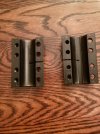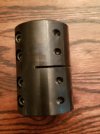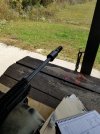First I watched every youtube video I could find on the subject, then I went out and bought some shaft collars, and couplers that would fit two of my rifles, and began experimenting a little. Lately, I read everything I could find on LRH from posts ranging from 2006 to present, then I searched for more details on the internet in general. I found Varmintal.com which is authored by a gentleman who retired from Lawrence Livermore labs, and spent his whole career running complex structural analysis on steel and other materials using models with time-steps and cells where the model calculates pressures, velocities, harmonics, and all the data 1 step and 1 cell at a time all the way from the ignition at firing down to the end of the barrel. This is called FEA analysis or Finite Element Analysis. He has a fascinating web site with a ton of science behind his conclusions. I understand harmonics because I had to have labs specializing in harmonic vibration on larger rotating compressors and machinery analyze harmonic vibrations which were tearing down multi-million dollar facilities.
Now, I know there are perhaps many on this site who will just say, you don't need a tuner, because if you reload, you can tune the harmonics out of your rifle with bullet seating, and powder selection and velocity/pressure optimization.
But, its clear to me from all the reading that I've done that there are just as many who will say, yes, you can get 70 or 80% there by bullet seating, and powder selection, and velocity/pressure measurement, and glass bedding, free floating, pillar bedding, and having a good stock. But there are just as many who will tell you they went from 0.5 MOA groups to 0.2 MOA groups or from 1 MOA plus groups to .75 MOA groups using a tuner after they did all of the above. It's maybe not critical for hunting in the 100-300 yard range. I usually shoot and tag 3-4 deer per year all from 30 yards to 150 yards max. But for long range hunting and ELR shooting, I would think any improvements in group size would be sort of important? Evidently, a lot more competitive benchrest shooters are using tuners than used to or were back in 2006? I have come to believe they can help improve groups even after good load development.
I'm looking for 1 ragged hole accuracy at 100 yards with all my rifles. So, I am considering buying and having a gun smith install tuners on several of my rifles.
Some of my questions were answered by my reading, and I had good results using my cheapo experiments especially on my .338 Lapua Magnum just using a $25 shaft collar that weighs about 1.8 lbs. It was hard for me to believe that part of my performance issues on MOA with this rifle were harmonics related, because it is a free floated barrel, and it's a big heavy barrel. I started to realize just how much pressure and velocity can affect even a big heavy barrel, and that all rifles have harmonics that have to be managed. My MOA went from around 1 down to 0.5 to .625 range when I installed the 1.8 shaft collar, using the same loads. That's when I knew that this rifle had a harmonics issue, even as big and heavy as it is.
My Lapua is the Savage BA 110 LE law enforcement model which weighs 17 lbs. with a 26 inch bbl. Plus Muzzle break, even with no scope etc. It's not a rifle I plan to carry further than from the car to the benchrest or to a portable benchrest looking out over a 500 or 700 yard long clear cut or wild flat canyon lands with a big view down on the Pecos in Texas. It's a firearm that is generally planned to be fired from a pre set or expedient station, not carried, certainly not in mountains.
Several things I have had on my mind. 1) How much weight is optimum for a barrel tuner, and does the length, and diameter and weight of the barrel have any correlation to that answer? I'm thinking that the 9 oz. to 12 oz. weights used in Harrell's and the EC Tuner may not be enough for a big heavy barrel? Nor may the muzzle brakes they build onto those tuners be sufficient or at least equal to what is already there. Its also clear to me that you can also overdo the weight of the tuner as Varmintal shows that in some of his experiments. How do you decide what is perfect for your rifle without running an FEA analysis? Someone must have some ideas or experience?
Since I have a standard factory Savage muzzle break on my .338 Lapua, what is the best tuner available commercially that incorporated an adequate or optimum break for a large caliber rifle if anyone makes one?
I know both Harrell's and Eric Cortina make tuners that incorporate muzzle breaks, but I need to make sure I get a good one for this rifle, and I don't care about weight vs. really good function.
Because the Savage factory muzzle break is designed with no ports on the bottom, it has more gas escaping straight up which forces the barrel downward too. Is this potentially one of my harmonics problems with the rifle? Is there a better muzzle break design for accuracy?
Some of the advantages I see for having a tuner are:
Now, I know there are perhaps many on this site who will just say, you don't need a tuner, because if you reload, you can tune the harmonics out of your rifle with bullet seating, and powder selection and velocity/pressure optimization.
But, its clear to me from all the reading that I've done that there are just as many who will say, yes, you can get 70 or 80% there by bullet seating, and powder selection, and velocity/pressure measurement, and glass bedding, free floating, pillar bedding, and having a good stock. But there are just as many who will tell you they went from 0.5 MOA groups to 0.2 MOA groups or from 1 MOA plus groups to .75 MOA groups using a tuner after they did all of the above. It's maybe not critical for hunting in the 100-300 yard range. I usually shoot and tag 3-4 deer per year all from 30 yards to 150 yards max. But for long range hunting and ELR shooting, I would think any improvements in group size would be sort of important? Evidently, a lot more competitive benchrest shooters are using tuners than used to or were back in 2006? I have come to believe they can help improve groups even after good load development.
I'm looking for 1 ragged hole accuracy at 100 yards with all my rifles. So, I am considering buying and having a gun smith install tuners on several of my rifles.
Some of my questions were answered by my reading, and I had good results using my cheapo experiments especially on my .338 Lapua Magnum just using a $25 shaft collar that weighs about 1.8 lbs. It was hard for me to believe that part of my performance issues on MOA with this rifle were harmonics related, because it is a free floated barrel, and it's a big heavy barrel. I started to realize just how much pressure and velocity can affect even a big heavy barrel, and that all rifles have harmonics that have to be managed. My MOA went from around 1 down to 0.5 to .625 range when I installed the 1.8 shaft collar, using the same loads. That's when I knew that this rifle had a harmonics issue, even as big and heavy as it is.
My Lapua is the Savage BA 110 LE law enforcement model which weighs 17 lbs. with a 26 inch bbl. Plus Muzzle break, even with no scope etc. It's not a rifle I plan to carry further than from the car to the benchrest or to a portable benchrest looking out over a 500 or 700 yard long clear cut or wild flat canyon lands with a big view down on the Pecos in Texas. It's a firearm that is generally planned to be fired from a pre set or expedient station, not carried, certainly not in mountains.
Several things I have had on my mind. 1) How much weight is optimum for a barrel tuner, and does the length, and diameter and weight of the barrel have any correlation to that answer? I'm thinking that the 9 oz. to 12 oz. weights used in Harrell's and the EC Tuner may not be enough for a big heavy barrel? Nor may the muzzle brakes they build onto those tuners be sufficient or at least equal to what is already there. Its also clear to me that you can also overdo the weight of the tuner as Varmintal shows that in some of his experiments. How do you decide what is perfect for your rifle without running an FEA analysis? Someone must have some ideas or experience?
Since I have a standard factory Savage muzzle break on my .338 Lapua, what is the best tuner available commercially that incorporated an adequate or optimum break for a large caliber rifle if anyone makes one?
I know both Harrell's and Eric Cortina make tuners that incorporate muzzle breaks, but I need to make sure I get a good one for this rifle, and I don't care about weight vs. really good function.
Because the Savage factory muzzle break is designed with no ports on the bottom, it has more gas escaping straight up which forces the barrel downward too. Is this potentially one of my harmonics problems with the rifle? Is there a better muzzle break design for accuracy?
Some of the advantages I see for having a tuner are:
- I may improve over just using my load development to manage harmonics
- It's tunable fairly easy for different factory or reloaded ammo.
- It can be fine tuned for differences in altitude, humidity, temperature if needed.
- It may save some costs on load development




